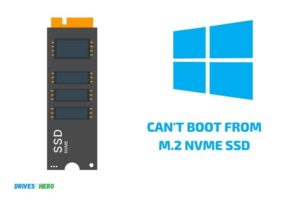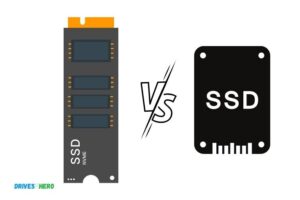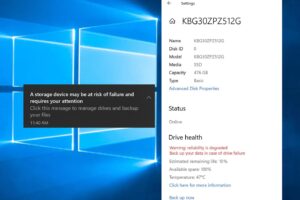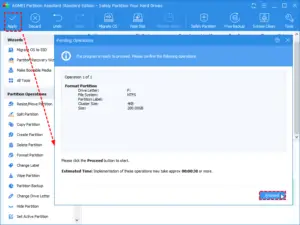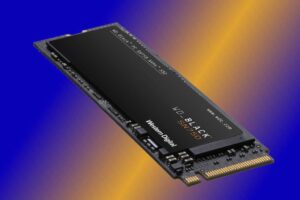How to Know If Laptop Supports Nvme Ssd? 7 Simple Steps!
Before upgrading your laptop’s storage to a faster NVMe SSD, it’s essential to ensure compatibility with your device. This guide provides a straightforward process to determine whether your laptop supports NVMe SSDs.
By following these steps, you can confidently assess compatibility and proceed with upgrading to a more efficient storage solution, enhancing your laptop’s performance and storage capabilities.

Key Takeaway
Checking NVMe SSD Compatibility with Your Laptop: Quick Steps
Step 1: Check Laptop Specifications
- Look up your laptop’s specifications online or consult the user manual.
- Search for information regarding supported storage interfaces.
Step 2: Identify Interface Types
- Determine if your laptop supports NVMe SSDs by identifying the types of storage interfaces it accommodates.
- NVMe SSDs typically use PCIe (Peripheral Component Interconnect Express) interface.
Step 3: Check Interface Speeds
- Verify the maximum interface speeds supported by your laptop’s storage interface.
- NVMe SSDs offer significantly faster speeds compared to traditional SATA SSDs.
Step 4: Review Compatibility Lists
- Search for compatibility lists provided by your laptop manufacturer or consult online forums and communities.
- Some manufacturers may explicitly mention NVMe SSD compatibility for specific laptop models.
Step 5: Check BIOS/UEFI Settings
- Access your laptop’s BIOS/UEFI settings during startup by pressing the designated key (e.g., F2, Del).
- Look for options related to storage devices or PCIe configurations.
- If NVMe SSD support is available, it may be mentioned in these settings.
Step 6: Consult Manufacturer Support
- Contact the laptop manufacturer’s customer support or visit their website for further assistance.
- Inquire about NVMe SSD compatibility for your specific laptop model.
Step 7: Use Diagnostic Tools
- Utilize diagnostic software or tools provided by the laptop manufacturer.
- Some tools may provide detailed information about supported storage devices, including NVMe SSDs.
By following these steps, you can determine whether your laptop supports NVMe SSDs, enabling you to upgrade to faster and more efficient storage solutions if compatible.
Five Facts About Checking Laptop Compatibility with NVMe SSDs
Understanding Nvme Ssd
To determine if your laptop supports NVMe SSD, check the technical specifications or consult the manufacturer’s website. Look for terms such as “NVMe support” or “M. 2 slot” which indicate compatibility with NVMe SSDs.
Here are some key points to help you better understand NVMe SSDs:
Faster Data Transfer: NVMe SSDs use the PCIe (Peripheral Component Interconnect Express) interface, which allows for faster data transfer rates compared to traditional SATA (Serial Advanced Technology Attachment) SSDs.
Reduced Latency: NVMe SSDs have significantly lower latency compared to traditional SSDs. This means that when you access or retrieve data from your NVMe SSD, there is less delay, resulting in a smoother and more efficient computing experience.
Parallel Processing: NVMe SSDs leverage parallel processing capabilities, which allow for simultaneous read and write operations.
This parallelism enhances the overall performance of the SSD, making data-intensive tasks such as gaming, video editing, and multitasking much smoother and faster.
Higher Storage Capacities: NVMe SSDs are available in a range of storage capacities, from smaller capacities suitable for everyday use to larger capacities for professional work and media storage. This flexibility allows you to choose the right NVMe SSD that meets your storage needs.
Compatibility: To ensure compatibility, it’s important to check whether your laptop supports NVMe SSDs. Most modern laptops and motherboards have NVMe compatibility, but it’s always a good idea to check your laptop’s specifications or consult with the manufacturer to confirm.
NVMe SSDs provide significant advantages over traditional SSDs, including faster data transfer, reduced latency, parallel processing capabilities, and a wide range of storage options.
Before upgrading your laptop’s storage, make sure to check whether your device supports NVMe SSDs, as it can greatly enhance your overall computing experience.
Checking Laptop Specifications
Looking to check if your laptop supports NVMe SSD? Learn how to easily know your laptop’s specifications and find out if it can accommodate NVMe SSD storage
Determining Laptop Model
Determining your laptop model is the first step towards finding out if it supports NVMe SSD.
Here’s how you can easily find your laptop model:
- Look for a label on the bottom of your laptop that displays the model number or serial number.
- Check the documentation or original packaging that came with your laptop.
- Open the System Information utility on your laptop and find the “System Model” or “Product Name” section.
Identifying Laptop Specifications
Once you’ve determined your laptop model, the next step is to identify its specifications. This will help you understand what components your laptop possesses and whether it supports NVMe SSD.
Here are some ways to find your laptop’s specifications:
- Access the System Information utility on your laptop and explore the “Processor,” “Memory,” and “Storage” sections.
- Open the Device Manager and expand the categories to see details about your laptop’s hardware components.
- Visit the manufacturer’s website and search for your laptop model to find detailed specifications.
Locating M.2 Slot
To support NVMe SSD, your laptop should have an M. 2 slot where you can install the drive.
Here’s how you can locate the M. 2 slot:
- Refer to your laptop’s user manual or documentation. Look for information on storage expansion or drive installation.
- Search for online resources, such as forums or community websites, where laptop users discuss hardware upgrades.
- Open your laptop’s casing and physically inspect the internal components to find the M.2 slot. Ensure you take necessary precautions or consult a professional if needed.
By following these steps to determine your laptop model, identify its specifications, and locate the M. 2 slot, you can confidently determine if your laptop supports NVMe SSD.
Remember to consult your laptop’s user manual or manufacturer’s website for specific information regarding compatibility and installation instructions.
Compatibility Check
Wondering if your laptop supports NVMe SSD? Easily check for compatibility with these simple steps and get ready to upgrade your storage for faster performance. No need to worry about technical jargon throughout the process.
Checking if your laptop supports NVMe SSD is crucial before making a purchase or upgrade. Fortunately, there are several methods you can use to verify compatibility.
Follow the steps below to ensure a smooth and hassle-free experience:
Checking Laptop Manufacturer’S Website:
To confirm if your laptop supports NVMe SSD, visit the official website of the laptop manufacturer. Look for the support or product page, where you can find detailed specifications and compatibility information.
Here’s how you can do it:
- Navigate to the manufacturer’s website.
- Go to the support or product page.
- Look for your specific laptop model or series.
- Locate the technical specifications section.
- Check if NVMe SSD support is listed.
- If NVMe is mentioned, your laptop supports it!
Checking Laptop User Manual:
Another reliable source to determine NVMe SSD compatibility is your laptop’s user manual.
Here’s how you can find the necessary information:
- Locate the user manual provided with your laptop.
- Look for the storage or upgrade section.
- Check if NVMe SSDs are mentioned as compatible options.
- If NVMe SSDs are listed, you’re in luck!
Reviewing Laptop Specifications:
Examining your laptop’s specifications can also shed light on its NVMe SSD compatibility.
Here’s what you need to do:
- Open the specifications page of your laptop.
- Look for the storage or drive section.
- Check if NVMe SSDs are supported or mentioned.
- If NVMe is listed, your laptop is compatible!
Consultation With Laptop Manufacturer’S Support:
If you’re still unsure about your laptop’s NVMe SSD compatibility, reaching out to the laptop manufacturer’s support team can provide you with a definitive answer.
Follow these steps to get assistance:
- Find the customer support contact details on the manufacturer’s website.
- Reach out to them via phone, chat, or email.
- Provide them with your laptop’s model and serial number.
- Ask if your laptop supports NVMe SSDs.
- The support team will guide you accordingly.
Checking the laptop manufacturer’s website, user manual, reviewing laptop specifications, or consulting with the manufacturer’s support team are the most reliable ways to determine if your laptop supports NVMe SSDs.
With this information in hand, you’ll be ready to enhance your storage capabilities and experience faster speeds with an NVMe SSD.
Upgrading Laptop To Nvme Ssd
Discovering whether your laptop supports an NVMe SSD upgrade? Check the specifications or consult the manufacturer’s website to ensure compatibility before upgrading your laptop’s storage for enhanced performance.
Purchasing The Compatible Nvme Ssd:
When it comes to purchasing an NVMe SSD for your laptop, it’s crucial to ensure compatibility.
Here are some key factors to consider:
- Check your laptop’s specifications: Verify if your laptop supports NVMe SSDs. Consult the manufacturer’s website or user manual for the information.
- Form factor: Determine the form factor supported by your laptop, such as M.2 or PCIe. This will help you choose the right NVMe SSD.
- Storage capacity: Determine the storage capacity you require. NVMe SSDs come in various sizes, ranging from 128GB to several terabytes.
Backing Up Data:
Before proceeding with any hardware changes, it’s essential to backup your data to prevent any potential loss.
Follow these steps to safeguard your valuable files:
- External storage: Connect an external storage device, such as an external hard drive or a USB flash drive, and copy all your important data.
- Cloud storage: Utilize cloud storage services like Google Drive or Dropbox to upload critical files and documents.
- Create an image: Consider creating a disk image using backup software to create a complete snapshot of your laptop’s drive.
Preparing Laptop For Installation:
Before installing the NVMe SSD, it’s important to prepare your laptop to ensure a seamless transition.
Here’s what you need to do:
- Update firmware and drivers: Make sure your laptop’s firmware and drivers are up to date to avoid any compatibility issues.
- Gather necessary tools: Gather the essential tools like a screwdriver and an anti-static wrist strap to prevent any damage during installation.
- Disable BitLocker: If you have BitLocker enabled on your current drive, ensure it is disabled to avoid any complications during the cloning process.
Installing The Nvme Ssd:
Now that you’ve taken the necessary steps to prepare, it’s time to install the NVMe SSD.
Follow these steps carefully:
- Locate the M.2 slot: Find the M.2 slot on your laptop’s motherboard. Consult your laptop’s manual or manufacturer’s website for the exact location.
- Insert the NVMe SSD: Gently insert the NVMe SSD into the M.2 slot at a 30-degree angle. Apply gentle pressure until it is properly seated.
- Secure with screws: Use the included screws to secure the NVMe SSD in place. Be cautious not to over tighten.
Congratulations! You have successfully upgraded your laptop to an NVMe SSD. Now, you can enjoy lightning-fast speeds and improved performance for all your computing needs.
Troubleshooting Potential Issues
If you’re unsure whether your laptop supports NVMe SSD, there are a few ways to troubleshoot potential issues.
Check your laptop’s specifications, look for an NVMe slot, consult the manufacturer’s website, or seek assistance from a professional technician. By following these steps, you can determine if your laptop is compatible with NVMe SSD.
Updating Laptop Bios/UEFI Firmware:
- Check the manufacturer’s website for any available updates for your laptop’s BIOS/UEFI firmware.
- Download and install the latest updates following the manufacturer’s instructions.
Checking Compatibility With Specific Nvme Ssd Models:
- Review your laptop’s specifications to ensure compatibility with NVMe SSD.
- Consult the manufacturer’s documentation or website for a list of supported NVMe SSD models.
- Check the physical dimensions and interface requirements of the NVMe SSD to match with your laptop’s specifications.
Resolving Conflicts With Other Hardware Components:
- Check for conflicts with other hardware components by conducting a thorough hardware diagnostics.
- Remove any newly installed hardware that may be causing conflicts with the NVMe SSD.
- Update drivers for other hardware components to ensure compatibility with the NVMe SSD.
Seeking Professional Assistance If Necessary:
- If you have exhausted all troubleshooting options and the issue persists, it may be time to seek professional assistance.
- Consult a computer technician or reach out to the laptop manufacturer’s customer support for guidance.
- Explain the problem in detail, outlining the troubleshooting steps you have already taken.
Remember, resolving issues with your laptop supporting NVMe SSD requires careful troubleshooting and attention to detail.
By following these troubleshooting steps and seeking professional assistance if necessary, you can ensure the smooth operation of your NVMe SSD on your laptop.
FAQ On How To Know If Laptop Supports Nvme Ssd
What is an NVMe SSD?
NVMe (Non-Volatile Memory Express) is an interface protocol for connecting host systems to solid-state drives (SSDs).
It is optimized for increased performance and reduced latency when compared to traditional storage technologies such as SATA and SAS.
How do I know if my laptop supports an NVMe SSD?
Your laptop’s user manual should provide a list of components and specifications which should include whether it supports an NVMe SSD or not.
Alternatively, you can open your laptop and look for an available M.2 slot, which is common for NVMe SSDs.
What type of performance can I expect from an NVMe SSD?
An NVMe SSD can offer significantly faster transfer speeds than traditional hard drives.
Depending on the model, this can range from around 2400 MB/s for smaller capacity drives up to 3500 MB/s or more for higher-end drives.
What are the advantages of using an NVMe SSD?
Some of the advantages of using an NVMe SSD include faster data transfer speeds, greater storage capacity, lower power consumption, and improved reliability over traditional hard drives.
Is an NVMe SSD compatible with other laptops?
Not all laptops are designed to be compatible with NVMe SSDs. You should check the user manual for specific compatibility information before attempting to install one in your system.
Conclusion
Determining if your laptop supports NVMe SSD can be done through various methods. Checking the laptop’s specifications online is a quick and reliable way to confirm compatibility.
Examining the laptop’s motherboard or consulting the manufacturer’s documentation can provide valuable insights.
It’s important to understand the benefits of upgrading to an NVMe SSD, such as faster boot times and improved overall performance.
While the process may seem daunting at first, with the right information and research, you can successfully determine if your laptop is compatible with an NVMe SSD.
Remember to always double-check before making any purchases and consult with a professional if you’re unsure.

